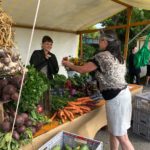When I was a child, I did not care much for apples. Why would I? For much of my life, flavours were shaped by upstream decisions made elsewhere and out of view. In post World War II America, the extraordinary expansion of industrial agriculture methods resulted in the decoupling of many local flavours to local sources. As a result, many once-prized local varieties of fruits, vegetables, grains, and more disappeared, and were replaced with ones that packed well for transport, produced in higher volume — especially with modern inputs and growing methods.
These changes brought both good and bad. Products that were once unavailable due to climate and distance, suddenly were on store shelves. On the other hand, these products squeezed out of the way many local favourites that began to lose their following. For me, in New Orleans, apples were likely scarce a century ago in local markets and supermarkets. The warm and wet climate does not provide enough chilling hours to produce apples reliably. At a dear price, locals could enjoy apples that were shipped in. However, they remained an expensive and guilty pleasure, rather than part of everyday life.
By the time I was born in the mid-1960s, apples were available in stores and almost year-round. However, only one variety of apple could be found: Washington state’s Red Delicious. It is red, but it otherwise does not live up to its namesake. So, how did it become so dominant? While the variety had been bred from older varieties, the one that reached supermarket shelf was bred for its uniformity, storability, and thicker skin. In other words, it was bred to accommodate the national infrastructure to deliver industrially scaled fruits from one part of the country to everywhere else effectively. It was not bred for flavour, or texture. One of its characteristics is its mealy texture.
Back to me, this was my first introduction to apples. I didn’t like the thick skin and did not care for its soft texture. To be fair, I have never eaten a Red Delicious apple right off the tree. Who knows? It might be delicious after all, but the ones they ship are uniformly dull. According to industry experts, the once dominant apple fell from favour rather dramatically and swiftly. In 1980, it represented 75% of harvests in Washington state, but by 2000 fewer than 50% of harvests were Red Delicious apples. Its numbers continue to decline.
What accounts for this drop? Several factors conspired to break the Red Delicious dominance. One, US Consumers began to experience more diverse apples: Honeycrisp, Gala, and Fuji varieties, for starters. Data from the field also reinforces this point. Farmers began to replace Red Delicious trees with these other varieties that began to capture consumers’ imaginations. Where and how did consumers begin to demand other varieties? They began to travel more widely and began to question why consumers in other countries enjoy other flavours and textures, while we are left with one or maybe two (Golden Delicious) apple varieties. The rise in the popularity of food magazines, television, and eventually social media also help to contribute to change.
Two, and then there are farmers markets. In the USA, they began to crop up in the 1990s in notable numbers. In 1996, USDA reported 1,600. Ten years later, their number climbed to over 8,000. Their proliferation provided the perfect opportunity for consumers to join forces with small farmers to learn from one another. This direct contact facilitates sales, but even more importantly, sales are accompanied by the transfer of knowledge. This speaks to the heart of how farmers markets set in motion product diversification trends that may begin rather small but then grow very rapidly.
Years later in New Orleans farmers markets, I began to rejoice at the unexpected arrival of fresh, local apples at farmers markets. Their arrival was celebrated by consumers, like me, who had never experienced the high-water content of a fresh apple directly from a farmer. As a result, children who are essentially educated about food in farmers markets begin with an entirely different point of reference. Rather than the Red Delicious as the quintessential apple, it became other, stranger varieties suited to the climate: Arkansas Black, Golden Dorsett or Anna.
It may take a few seasons for farmers to shift production of fruit trees. Other crops move even faster: Consider tomatoes (and the passion now widespread for heirloom varieties that had once been abandoned for the same concerns as the apples — uniformity, transport, etc.). The same can be said of other annuals: lettuces, cucumbers, and squash.
Whereas farmers benefit from learning directly from consumers who crave new flavours, so too do consumers learn from farmers. After all, in the Global North it is June as I write. If there are apples in the farmers market, this is because they are last year’s crops stored properly. Consumers have the opportunity to learn from farmers as to how and when to expect crops, varieties, etc. Moreover, with accrued knowledge, consumers become part of a farmers market’s internal policy mechanism. As consumers become more knowledgeable, they become the first line of defence to protect the integrity of local direct marketing. How many times have I noticed it to be a shopper who informs a market manager of “suspiciously out of season products on offer in a stall.”
All of these changes are due to the intentional “architecture of place” of farmers markets. The broadening of consumer tastes does not just occur. It is coordinated on the ground by farmers and consumers together, beneath the canopy of farmers markets. As a result, we must learn to map which products are present, which ones are disappearing, and which ones are to be celebrated. Tools to revive old varieties include the Slow Food Ark of Taste. The World Localization Day in the month of June (which we support, with our Eat Local Challenge) is another. I encourage you to recognize the diversity of offerings, just as it is our duty to recognize the lack of offerings. This is our farmers market challenge: To serve as a mirror that captures the health of a local food system, and to serve as a hammer to tap it into a healthier, more biodiverse direction.






